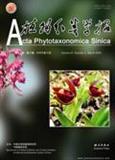Pollen morphology of seven species in two genera in the Ruelliinae, three species in one genus in the Barlerinae and 34 species in 16 genera in the Strobilanthinae (Ruellieae, Acanthaceae), were observed under SEM. Pollen grains in Ruellieae, particularly in Strobilanthinae (including Strobilanthes s.l.) exhibit great diversity and are most eurypalynous in the family. In light of the aperture types and exine ornamentation patterns, pollen grains of the genera examined fall into three major types: 1. 3-porate pollen, which includes, (1) pollen with reticulate exine ornamentation (Pararuellia); (2) pollen with gemmate exine ornamentation (Championella); (3) pollen with echinate exine ornamentation (Paragutzlaffia, Diflugossa and Pteroptychia). 2. 3-colporate pollen or 3-colporate pollen with pseudocolpi, which includes, (1) 3-colporate pollen with reticulate exine ornamentation (Eranthemum and Barleria); (2) 3-colporate pollen with pseudocolpi and ribbed or banded, and septate exine ornamentation, the lumina rounded, finely reticulate inside and arranged in longitudinal rows (Perilepta, Pteracanthus, Goldfussia, Sympagis and some species of Strobilanthes); (3) 3-colporate pollen with ribbed or banded yet not septate exine ornamentation, the lumina neither distinctly rounded and finely reticulate inside, nor conspicuously arranged in longitudinal rows (Aechmanthera, Baphicacanthus, Semnostachya and some species of Pteracanthus); and (4) 3-colporate pollen with ribbed and finely reticulate exine ornamentation but with broader bands, each band with two ridges (Strobilanthes cycla). 3. (4-)5-colporate pollen with pseudocolpi and reticulate or ornate exine ornamentation (Adenacanthus). No distinct apertures were observed in three genera, Parachampionella, Gutzlaffia and Tarphochlamys. Pollen morphological characters in the Acanthaceae can be used not only to distinguish taxa of higher ranks (subfamily, tribe and subtribe) and elucidate their relationships, but sometimes can also be used to distinguish genera and species.










